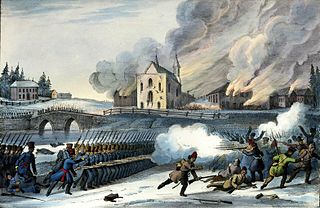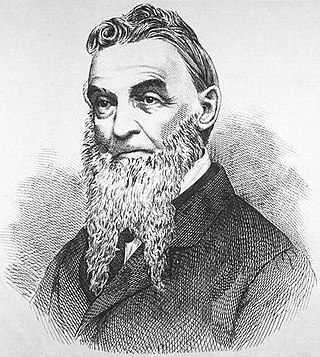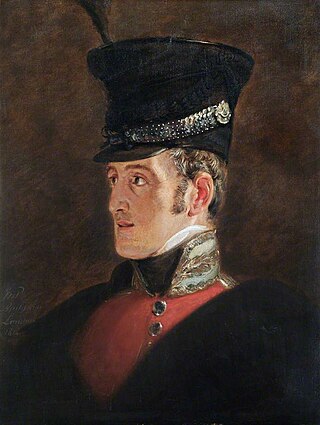
The Lower Canada Rebellion, commonly referred to as the Patriots' Rebellion in French, is the name given to the armed conflict in 1837–38 between rebels and the colonial government of Lower Canada. Together with the simultaneous rebellion in the neighbouring colony of Upper Canada, it formed the Rebellions of 1837–38.

The Upper Canada Rebellion was an insurrection against the oligarchic government of the British colony of Upper Canada in December 1837. While public grievances had existed for years, it was the rebellion in Lower Canada, which started the previous month, that emboldened rebels in Upper Canada to revolt.
The Battle of Windsor was a short-lived campaign in the eastern Michigan area of the United States and the Windsor area of Upper Canada. A group of men on both sides of the border, calling themselves "Patriots", formed small militias in 1837 with the intention of seizing the Southern Ontario peninsula between the Detroit and Niagara Rivers and extending American-style government to Canada. They based groups in Michigan at Fort Gratiot, Mount Clemens, Detroit, and Gibraltar. The Patriots were defeated by British and American government forces, respectively.

The Rebellions of 1837–1838, were two armed uprisings that took place in Lower and Upper Canada in 1837 and 1838. Both rebellions were motivated by frustrations with lack of political reform. A key shared goal was responsible government, which was eventually achieved in the incidents' aftermath. The rebellions led directly to Lord Durham's Report on the Affairs of British North America and to the Act of Union 1840 which partially reformed the British provinces into a unitary system and eventually led to the British North America Act, 1867, which created the contemporary Canadian federation and its government.

Robert Nelson was an Anglo-Quebecer physician and a leading figure in the Lower Canada Rebellion in 19th century Quebec.

Events from the year 1838 in Canada.

Pelee Island is an island in the Canadian province of Ontario. It is located in the western half of Lake Erie. At 42 km2 (16 sq mi), Pelee Island is the largest island in Lake Erie and the southernmost populated point in Canada. An Ontario Historical Plaque was erected by the province to commemorate the development of Pelee Island's role in Ontario's heritage. Nearby Middle Island is the southernmost point of land in Canada.

Field Marshal John Colborne, 1st Baron Seaton, was a British Army officer and colonial governor. After taking part as a junior officer in the Anglo-Russian invasion of Holland, Sir Ralph Abercromby's expedition to Egypt and then the War of the Third Coalition, he served as military secretary to Sir John Moore at the Battle of Corunna. He then commanded the 2nd Battalion of the 66th Regiment of Foot and, later, the 52nd Regiment of Foot at many of the battles of the Peninsular War. At the Battle of Waterloo, Colborne on his own initiative brought the 52nd Regiment of Foot forward, took up a flanking position in relation to the French Imperial Guard and then, after firing repeated volleys into their flank, charged at the Guard so driving them back in disorder.

The Republic of Canada was a government proclaimed by William Lyon Mackenzie on December 5, 1837. The self-proclaimed government was established on Navy Island in the Niagara River in the latter days of the Upper Canada Rebellion.

The Battle of the Windmill was fought in November 1838 in the aftermath of the Upper Canada Rebellion. Loyalist forces of the Upper Canadian government and American troops, aided by the Royal Navy and U.S. Navy, defeated an invasion attempt by a Hunter Patriot para-military unit based in the United States, which had the intention of using the beachhead as a launchpad for further offensives into Canada. Canadian, British, and American troops thwarted the invasion, successfully defending Canadian soil and forced the invaders to surrender. Others still in the U.S. were captured and arrested by U.S. officials.

The 32nd Regiment of Foot was an infantry regiment of the British Army, raised in 1702. Under the Childers Reforms it amalgamated with the 46th Regiment of Foot to form the Duke of Cornwall's Light Infantry in 1881.

The Battle of Saint-Denis was fought on November 23, 1837, between British colonial authorities under Lieutenant-Colonel Gore and Patriote rebels in Lower Canada as part of the Lower Canada Rebellion. The Patriotes were led by Wolfred Nelson. Gore was sent to quell the uprising in the Richelieu River valley in conjunction with a force led by Lieutenant-Colonel George Wetherall. Gore was the first to arrive at a Patriote-held site. Nelson had organized the defence with most of the well-armed rebels within a stone house that overlooked the road. Gore, accompanied by only one cannon, attempted to take the stone house three times, with the cannon providing ineffective fire. Another attempt to flank the house to the left failed when Gore's soldiers encountered the less well-armed militia. Running out of ammunition, the British retreated. This marked the only Patriote victory in 1837, as this battle was followed by two defeats at Saint-Charles and Saint-Eustache.

The Battle of Saint-Charles was fought on 25 November 1837 between the Government of Lower Canada, supported by the United Kingdom, and Patriote rebels. Following the opening Patriote victory of the Lower Canada Rebellion at the Battle of Saint-Denis, British troops under the command of Lieutenant Colonel George Wetherall advanced from the south on the Patriote stronghold of Saint-Charles in the Richelieu valley. On 25 November 1837 they engaged the Patriote forces under the command of Thomas Storrow Brown. After a two-hour battle, the Government of Lower Canada was victorious.

The Battle of Saint-Eustache was a decisive battle in the Lower Canada Rebellion in which government forces defeated the principal remaining Patriotes camp at Saint-Eustache on December 14, 1837.
John Prince, was a lawyer, militia officer, gentleman farmer and political figure in Upper Canada and Canada West.

Fort Wellington National Historic Site is a historic military fortification located on the north shore of the St. Lawrence River at Prescott, Ontario. The military fortification was used by the British Army, and the Canadian militia for most of the 19th century, and by the militia in the 20th century, until 1923, when the property was handed over to the Dominion Parks Commission, the predecessor to Parks Canada. The fort was earlier named a National Historic Site of Canada in January 1920.
The 83rd Regiment of Foot was a British Army line infantry regiment, which was formed in Ireland in 1793 for service in the French Revolutionary Wars. The regiment served in the West Indies, South Africa and the Peninsular War, and after the end of the wars with France spent much of the nineteenth century in colonial garrisons. Among other service, the 83rd fought in the Ceylon Great Rebellion of 1817–18, the Canadian Rebellions of 1837, and the Indian Rebellion of 1857. Under the Childers Reforms, the regiment amalgamated with the 86th Regiment of Foot to form the Royal Irish Rifles in 1881.

The Patriot War was a conflict along the Canada–United States border in which bands of raiders attacked the British colony of Upper Canada more than a dozen times between December 1837 and December 1838. This so-called war was not a conflict between nations; it was a war of ideas fought by like-minded people against British forces, with the British eventually allying with the US government against the Patriots.
The Battle of Baker's Farm took place in Lower Canada on November 8, 1838, during the Patriot's War. It was the first and last military success of the Patriotes in the campaign of 1838. Eight hundred Patriotes gathered on a farm near Sainte-Martine, Quebec and fought off several attacks by Loyalist volunteers. After news of the defeat of Patriotes forces at the Battle of Odelltown spread, the massed Patriotes dispersed before the arrival of British troops.











